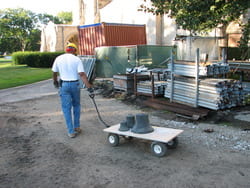Restoration of the Carillon
History
The restoration of the carillon
By the late 1990s, the Rockefeller carillon needed major restorative work. The bells, brought from London and installed in 1932, had suffered the effects of three-quarters of a century of Chicago winters.
The soft iron clappers had become flattened from repeatedly striking the harder bronze of the bells (they had been turned 180 degrees in the 1960s to present once again a round surface to the bells, but no further turning was possible). And the outmoded early twentieth century mechanism connecting the clappers to the playing console (using heavy connecting rods, and counterweights for the largest bells) had deteriorated over the years.

Time for an overhaul
There were other issues too. In the original layout, to a design by Frederick Mayer of West Point, the fourteen largest bells had been placed below the playing cabin, and all the other bells above it, with trapdoors in the cabin allowing the performer to hear a balanced sound. Listeners on the ground, however, heard the larger bells to the exclusion of the smaller ones.
The overhaul which took place between 2006 and 2008 remedied all of these problems.
Back to Europe
Forty-six of the bells were shipped to the Royal Eijsbouts foundry in the Netherlands for restoration, and returned almost two years later. During their absence, work was undertaken in the tower.
- The upper belfry was reorganized so that the smallest bells could be placed at the top of the bell frame, giving them optimal exposure to listeners below.
- The playing cabin was completely rebuilt so that it would comfortably seat 20 visitors, with heating and air conditioning added.
- The playing console was reoriented in the tower to shorten the length of the connections to the bells.
- The old-fashioned connecting rods were replaced by lightweight wires, and new clappers were provided for the 58 smaller bells. These clappers are on round shanks, allowing them to be turned numerous times as flat spots develop.
- A new L-shaped directed crank design was installed, using shorter wires and less mass, resulting in a more responsive carillon.
- The old counterweights were replaced by springs to assist the performer in moving the largest clappers.
- Finally, the Gothic-style carved oak keyboard and pedalboard were restored and updated to a modern standard key layout, of a kind familiar to performers from all over the world.

